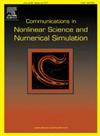Superconvergent error estimates of linearized BDF2/Leapfrog schemes with H1-Galerkin MFEM for strongly nonlinear moisture migration equation
IF 3.8
2区 数学
Q1 MATHEMATICS, APPLIED
Communications in Nonlinear Science and Numerical Simulation
Pub Date : 2025-10-08
DOI:10.1016/j.cnsns.2025.109410
引用次数: 0
Abstract
In this paper, the linearized two-step backward differentiation formula (BDF2) and Leapfrog schemes are developed for the strongly nonlinear moisture migration equation based on -Galerkin mixed finite element method (MFEM) with element pair . Then, the numerical solutions are rigorously proved to be bounded in the broken -norm by use of some special approaches such as the mathematical induction and high-precision results. Furthermore, the superclose and superconvergence results with order for the proposed schemes are obtained by exploiting the typical characters of this element pair and the interpolation post-processing technique, where and represent the spatial mesh size and time step, respectively. Finally, the theoretical outcomes are verified by two numerical examples.
强非线性水分迁移方程线性化BDF2/Leapfrog[公式略]-Galerkin MFEM的超收敛误差估计
基于单元对Q11/Q10×Q01的h11 - galerkin混合有限元法(MFEM),建立了强非线性水分迁移方程的线性化两步后向微分公式(BDF2)和Leapfrog格式。然后,利用数学归纳法和高精度结果等特殊方法,严格证明了数值解在h1 -范数破环中是有界的。利用该单元对的典型特征和插值后处理技术,得到了该方案的超接近和O(h2+τ2)阶的超收敛结果,其中h和τ分别代表空间网格尺寸和时间步长。最后,通过两个算例验证了理论结果。
本文章由计算机程序翻译,如有差异,请以英文原文为准。
求助全文
约1分钟内获得全文
求助全文
来源期刊

Communications in Nonlinear Science and Numerical Simulation
MATHEMATICS, APPLIED-MATHEMATICS, INTERDISCIPLINARY APPLICATIONS
CiteScore
6.80
自引率
7.70%
发文量
378
审稿时长
78 days
期刊介绍:
The journal publishes original research findings on experimental observation, mathematical modeling, theoretical analysis and numerical simulation, for more accurate description, better prediction or novel application, of nonlinear phenomena in science and engineering. It offers a venue for researchers to make rapid exchange of ideas and techniques in nonlinear science and complexity.
The submission of manuscripts with cross-disciplinary approaches in nonlinear science and complexity is particularly encouraged.
Topics of interest:
Nonlinear differential or delay equations, Lie group analysis and asymptotic methods, Discontinuous systems, Fractals, Fractional calculus and dynamics, Nonlinear effects in quantum mechanics, Nonlinear stochastic processes, Experimental nonlinear science, Time-series and signal analysis, Computational methods and simulations in nonlinear science and engineering, Control of dynamical systems, Synchronization, Lyapunov analysis, High-dimensional chaos and turbulence, Chaos in Hamiltonian systems, Integrable systems and solitons, Collective behavior in many-body systems, Biological physics and networks, Nonlinear mechanical systems, Complex systems and complexity.
No length limitation for contributions is set, but only concisely written manuscripts are published. Brief papers are published on the basis of Rapid Communications. Discussions of previously published papers are welcome.
 求助内容:
求助内容: 应助结果提醒方式:
应助结果提醒方式:


